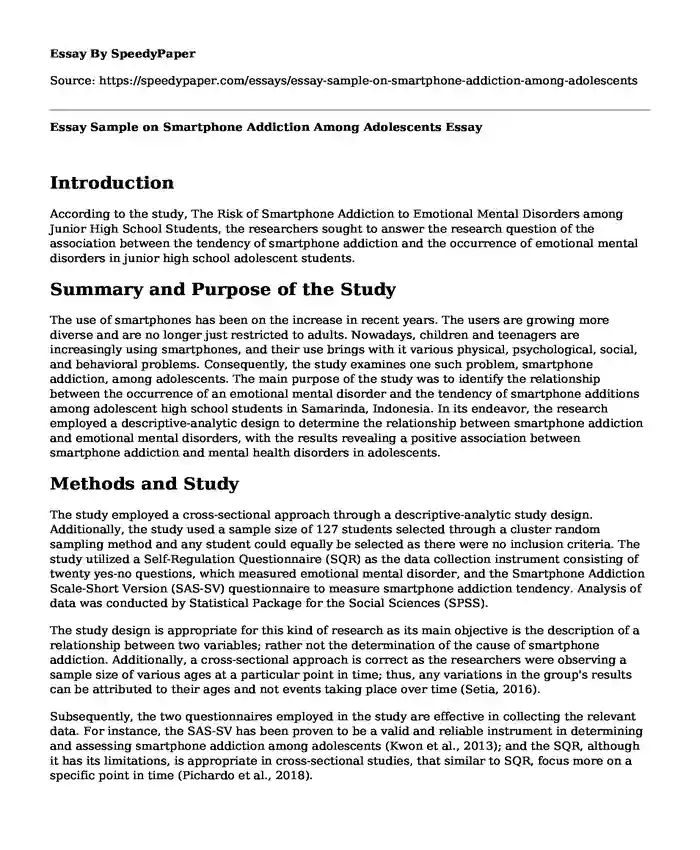
| Type of paper: | Course work |
| Categories: | Mental health |
| Pages: | 3 |
| Wordcount: | 720 words |
Introduction
According to the study, The Risk of Smartphone Addiction to Emotional Mental Disorders among Junior High School Students, the researchers sought to answer the research question of the association between the tendency of smartphone addiction and the occurrence of emotional mental disorders in junior high school adolescent students.
Summary and Purpose of the Study
The use of smartphones has been on the increase in recent years. The users are growing more diverse and are no longer just restricted to adults. Nowadays, children and teenagers are increasingly using smartphones, and their use brings with it various physical, psychological, social, and behavioral problems. Consequently, the study examines one such problem, smartphone addiction, among adolescents. The main purpose of the study was to identify the relationship between the occurrence of an emotional mental disorder and the tendency of smartphone additions among adolescent high school students in Samarinda, Indonesia. In its endeavor, the research employed a descriptive-analytic design to determine the relationship between smartphone addiction and emotional mental disorders, with the results revealing a positive association between smartphone addiction and mental health disorders in adolescents.
Methods and Study
The study employed a cross-sectional approach through a descriptive-analytic study design. Additionally, the study used a sample size of 127 students selected through a cluster random sampling method and any student could equally be selected as there were no inclusion criteria. The study utilized a Self-Regulation Questionnaire (SQR) as the data collection instrument consisting of twenty yes-no questions, which measured emotional mental disorder, and the Smartphone Addiction Scale-Short Version (SAS-SV) questionnaire to measure smartphone addiction tendency. Analysis of data was conducted by Statistical Package for the Social Sciences (SPSS).
The study design is appropriate for this kind of research as its main objective is the description of a relationship between two variables; rather not the determination of the cause of smartphone addiction. Additionally, a cross-sectional approach is correct as the researchers were observing a sample size of various ages at a particular point in time; thus, any variations in the group's results can be attributed to their ages and not events taking place over time (Setia, 2016).
Subsequently, the two questionnaires employed in the study are effective in collecting the relevant data. For instance, the SAS-SV has been proven to be a valid and reliable instrument in determining and assessing smartphone addiction among adolescents (Kwon et al., 2013); and the SQR, although it has its limitations, is appropriate in cross-sectional studies, that similar to SQR, focus more on a specific point in time (Pichardo et al., 2018).
Variable Definition and Operationalization
The variables involved in the study include the emotional mental disorder which is the dependant variable and smartphone addiction as the independent variable. The dependant variable was operationalized through twenty yes-no questions in the SRQ. Six or more "yes" responses indicated that the respondent had an emotional health disorder. On the other hand, the dependent variable included responses coded on a five-point Likert scale ranging from "strongly agree" (5) to "strongly disagree" (1)
Research Ethical Considerations
The study can be considered as ethically sound as for starters, there was no bias in the selection of the sample size. As stated by the authors, there were no selection criteria and all students had an equal chance of being selected. Furthermore, various ethical considerations are detailed in the study. For instance, the researchers sought permission from the school before data collection commenced. Written permission was obtained from the schools' headmasters to conduct the research as well as written informed consent forms from the participants signifying their voluntary involvement in the study. Subsequently, full research disclosures were provided with the assurance of anonymity and confidentiality in their participation.
References
Kwon, M., Kim, D. J., Cho, H., & Yang, S. (2013). The smartphone addiction scale: development and validation of a short version for adolescents. PloS one, 8(12). https://doi.org/10.1371/journal.pone.0083558
Pichardo, M. C., Cano, F., Garzon-Umerenkova, A., de la Fuente, J., Peralta-Sanchez, F. J., & Amate-Romera, J. (2018). Self-regulation questionnaire (SRQ) in Spanish adolescents: factor structure and rasch analysis. Frontiers in psychology, 9(1370), 1-8. https://doi.org/10.3389/fpsyg.2018.01370
Setia, M. S. (2016). Methodology series module 3: Cross-sectional studies. Indian journal of dermatology, 61(3), 261-264. https://doi.org/ 10.4103/0019-5154.182410
Setiadi, R., Tini, T., Sukamto, E., & Kalsum, U. (2019). The risk of smartphone addiction to emotional mental disorders among junior high school students. Belitung Nursing Journal, 5(5), 197-203. https://doi.org/10.33546/bnj.841
Cite this page
Essay Sample on Smartphone Addiction Among Adolescents. (2023, May 01). Retrieved from https://speedypaper.net/essays/essay-sample-on-smartphone-addiction-among-adolescents
Request Removal
If you are the original author of this essay and no longer wish to have it published on the SpeedyPaper website, please click below to request its removal:
- Descriptive Essay Example on Chipotle Restaurant
- Essay Example on the Problems in Healthcare Organizations
- Free Essay: Education Issues for Children with Learning Disabilities
- Free Essay Exploring English Grammar
- Free Essay on Porter's Competitive Strategies
- A Tale of Two Cities: Free Essay about Chicago and Detroit
- Free Essay Example: Animals Testing and Experimentation
Popular categories




